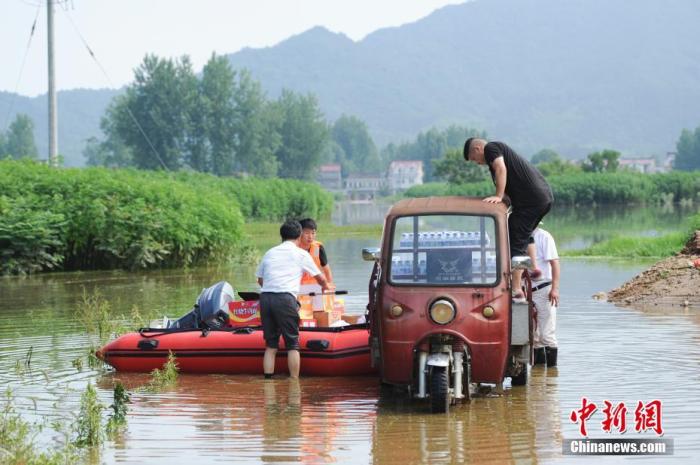China News Service, July 28. According to the official Weibo news of the Ministry of Emergency Management, as of July 28, floods have caused 54.811 million disasters in 27 provinces (autonomous regions and municipalities) including Jiangxi, Anhui and Hubei since the main flood season, causing direct economic damage. The loss was 144.43 billion yuan. The National Defense Economics Conference decided to maintain the second-level response for flood control in the Yangtze and Huaihe Rivers. This is to maintain the second-level response for 17 consecutive days.
Data map: In Xihekou Township, Yu'an District, Lu'an City, Anhui Province, rescuers are preparing to use kayaks to transport supplies to the trapped people. Photo by China News Agency reporter Zhang Yazi
At present, the water level in the middle and lower reaches of the Yangtze River below Shitou and the two lakes continue to be over-alarmed. Among them, the Lianhuatang and Dongting Lake Chenglingji in the mainstream of the Yangtze River have exceeded the guaranteed water level, and the sections below Wangjiaba of the Huai River are still over-alarmed.
Huang Ming, deputy commander-in-chief of the State Administration of Defense and Secretary of the Party Committee of the Ministry of Emergency Management, presided over a flood prevention and disaster relief meeting, discussed and judged rainwater and flood conditions with the Ministry of Water Resources, the Ministry of Natural Resources, and the China Meteorological Administration, and further deployed the Yangtze and Huaihe River basins and key northern areas for flood control Disaster relief work. The meeting emphasized that it is necessary to pay close attention to the development trend of the flood situation, guide and urge key areas to strictly implement various flood prevention and disaster relief responsibilities, further strengthen flood monitoring and early warning and risk investigation, highlight the inspection and defense of key areas and important dikes, and eliminate major hidden risks in a timely manner. We will pay close attention to various tasks such as force deployment, material storage, transfer and avoidance, and post-disaster resettlement assistance, and actively help the affected people to restore the order of production and life as soon as possible.
After the rain belt moves northward on July 29, heavy rainfall will occur in the Huanghuai, North China, and Northeast regions, and heavy flooding may occur in the Haihe, Yellow and Songliao rivers. The State Administration of Defense and the Ministry of Emergency Management require key northern areas to resolutely overcome paralysis and fluke mentality, based on the prevention of major floods, fighting against major floods, rushing for major risks, and rescuing major disasters, layering the responsibility for flood prevention, and further conducting risk investigation and hidden dangers Rectify, strengthen forecasting and early warning, consultation and judgment, strengthen inspections and defenses, implement emergency rescue teams and materials, highlight the prevention of disasters such as floods, mountain torrents, landslides, mudslides, and urban waterlogging in small and medium-sized rivers, timely transfer threatened people, and ensure people’s lives Put safety first and put it into practice.
The State General Prevention Working Group continued to strengthen front-line inspection and guidance, and urged all localities to further implement various measures for flood prevention, disaster relief and disaster relief. The flood control team of the Anhui Working Group inspected the operation of flood control projects, dike inspections and dangers, and resettlement of displaced people in Wangjiaba Gate, Huaihe Dike, Mengwa Flood Storage and Detention Area Baozhuangwei, and Huxinzhuangtai; the disaster relief team was in Lujiang County, Hefei City The Changgang Middle School resettlement site and other places checked the disaster situation and inspected the work related to the centralized resettlement site of the victims. The Jiangxi working group inspected and guided emergency flood drainage work in Sanjiao Lianwei and Lixinwei in Yongxiu County, Jiujiang City. The Hunan working group guided the inspection of disaster relief, levee inspections, and hidden geological hazards in Dongping Town and Xiaoyan Town, Anhua County, Yiyang City. The Hubei working group inspected and guided the disposal of dangerous points such as the water gushing in the pressure relief well of Changsun Di in Huangzhou District, the blocking of the towns Luchong, and the collapse of the town lotus picking boat. The Jiangsu working group inspected the flood control conditions of key facilities in Qingjiangpu District and Huai'an District of Huai'an City, including Erhe Gate, Huai'an Water Control Project, and Yundong Gate of Subei Irrigation Main Canal.
According to statistics from the Ministry of Emergency Management, as of July 28, since the main flood season (June 1), floods have caused 54.811 million disasters in 27 provinces (autonomous regions and municipalities) including Jiangxi, Anhui, and Hubei, with 158 dead and missing, and 3.76 million. Emergency transfer and resettlement of people; 41,000 houses collapsed and 368,000 damaged to varying degrees; crops affected area of 5283.3 thousand hectares; direct economic loss was 144.43 billion yuan. Compared with the average of the same period in the past five years, the number of people affected by disasters increased by 23.4%, the number of people killed and missing due to disasters decreased by 53.9%, the number of emergency transfers increased by 36.7%, the number of collapsed houses decreased by 68.4%, and the direct economic loss increased by 13.8%.

